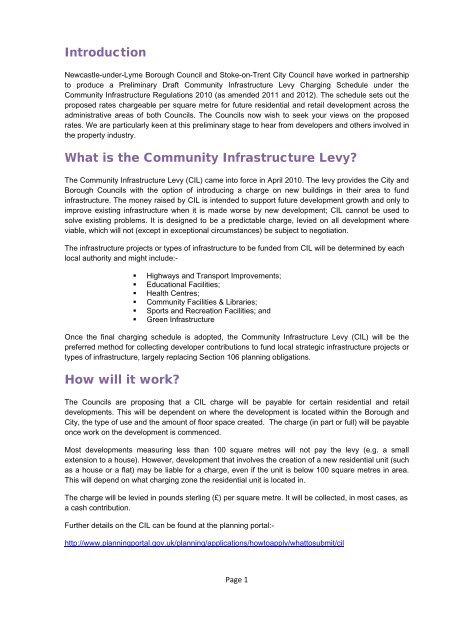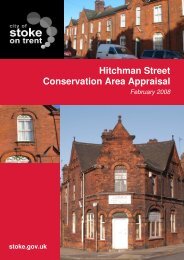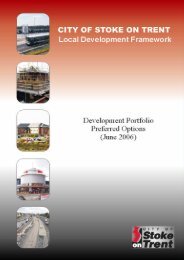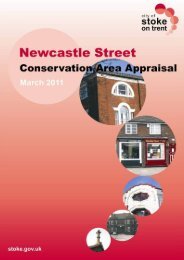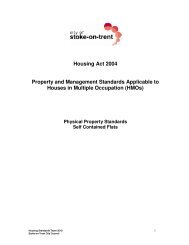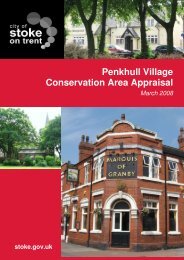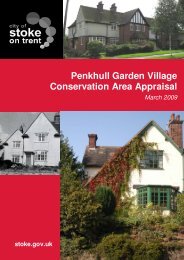draft charging schedule - Stoke-on-Trent City Council
draft charging schedule - Stoke-on-Trent City Council
draft charging schedule - Stoke-on-Trent City Council
- No tags were found...
You also want an ePaper? Increase the reach of your titles
YUMPU automatically turns print PDFs into web optimized ePapers that Google loves.
Introducti<strong>on</strong>Newcastle-under-Lyme Borough <strong>Council</strong> and <str<strong>on</strong>g>Stoke</str<strong>on</strong>g>-<strong>on</strong>-<strong>Trent</strong> <strong>City</strong> <strong>Council</strong> have worked in partnershipto produce a Preliminary Draft Community Infrastructure Levy Charging Schedule under theCommunity Infrastructure Regulati<strong>on</strong>s 2010 (as amended 2011 and 2012). The <str<strong>on</strong>g>schedule</str<strong>on</strong>g> sets out theproposed rates chargeable per square metre for future residential and retail development across theadministrative areas of both <strong>Council</strong>s. The <strong>Council</strong>s now wish to seek your views <strong>on</strong> the proposedrates. We are particularly keen at this preliminary stage to hear from developers and others involved inthe property industry.What is the Community Infrastructure Levy?The Community Infrastructure Levy (CIL) came into force in April 2010. The levy provides the <strong>City</strong> andBorough <strong>Council</strong>s with the opti<strong>on</strong> of introducing a charge <strong>on</strong> new buildings in their area to fundinfrastructure. The m<strong>on</strong>ey raised by CIL is intended to support future development growth and <strong>on</strong>ly toimprove existing infrastructure when it is made worse by new development; CIL cannot be used tosolve existing problems. It is designed to be a predictable charge, levied <strong>on</strong> all development whereviable, which will not (except in excepti<strong>on</strong>al circumstances) be subject to negotiati<strong>on</strong>.The infrastructure projects or types of infrastructure to be funded from CIL will be determined by eachlocal authority and might include:-• Highways and Transport Improvements;• Educati<strong>on</strong>al Facilities;• Health Centres;• Community Facilities & Libraries;• Sports and Recreati<strong>on</strong> Facilities; and• Green InfrastructureOnce the final <str<strong>on</strong>g>charging</str<strong>on</strong>g> <str<strong>on</strong>g>schedule</str<strong>on</strong>g> is adopted, the Community Infrastructure Levy (CIL) will be thepreferred method for collecting developer c<strong>on</strong>tributi<strong>on</strong>s to fund local strategic infrastructure projects ortypes of infrastructure, largely replacing Secti<strong>on</strong> 106 planning obligati<strong>on</strong>s.How will it work?The <strong>Council</strong>s are proposing that a CIL charge will be payable for certain residential and retaildevelopments. This will be dependent <strong>on</strong> where the development is located within the Borough and<strong>City</strong>, the type of use and the amount of floor space created. The charge (in part or full) will be payable<strong>on</strong>ce work <strong>on</strong> the development is commenced.Most developments measuring less than 100 square metres will not pay the levy (e.g. a smallextensi<strong>on</strong> to a house). However, development that involves the creati<strong>on</strong> of a new residential unit (suchas a house or a flat) may be liable for a charge, even if the unit is below 100 square metres in area.This will depend <strong>on</strong> what <str<strong>on</strong>g>charging</str<strong>on</strong>g> z<strong>on</strong>e the residential unit is located in.The charge will be levied in pounds sterling (£) per square metre. It will be collected, in most cases, asa cash c<strong>on</strong>tributi<strong>on</strong>.Further details <strong>on</strong> the CIL can be found at the planning portal:-http://www.planningportal.gov.uk/planning/applicati<strong>on</strong>s/howtoapply/whattosubmit/cilPage 1


